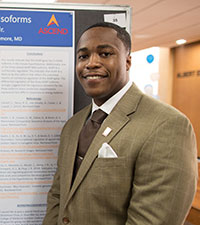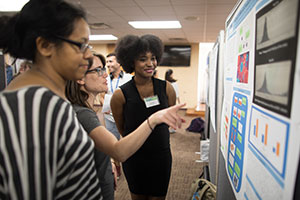

Diverse Opportunities in Science
Summer Research Programs Offer Diverse Undergrads Insights into Careers Options
This summer was a bit of an experiment for Kayla Baker and Fred Johnson III. Both are undergraduate biology majors at Historically Black Colleges and Universities (HBCU) with an interest in pursuing a career in medicine that also includes research, but when they arrived at Einstein in June neither of them had much experience working in a lab.

Fred Johnson III, SURP participantThat’s why Kayla participated in Einstein’s Diversity Summer Student Research Opportunity Program (DSSROP) and Fred took part in the College of Medicine’s Summer Undergraduate Research Program (SURP). The related programs collectively offer dozens of undergraduate students from around the nation the opportunity to gain hands-on research experience while living on campus.
Each knew the importance of research and how crucial it was to medicine, but would the notion of conducting studies still appeal to them after eight weeks of long hours at a laboratory bench?
“For me, it was like a big checkmark,” said Kayla, who will start senior year at Tuskegee University, in Alabama. “At first I wasn’t sure, but when I started doing research I knew it’s what I want to do.”
“This summer was a confirmation,” agreed Fred, a senior at Morgan State University, in Baltimore, MD. “Research is what I should be doing, this is what I was called to do.”
Diversifying the Medical School Pipeline
Both he and Kayla want to combine research with medicine to reduce health disparities in minority and underserved communities. They were two of the 10 students from HBCUs who spent their summer at Einstein as part of DSSROP and SURP.
DSSROP is run by Einstein’s office of diversity enhancement and attempts to expose students from groups that have been underrepresented in medicine and science to the possibilities of careers in research. It is part of a collaboration with SURP, a larger summer program run by Einstein’s Graduate Division of Biomedical Sciences, which welcomes 30 to 50 undergraduates annually to experience research in one of Einstein’s 300 labs.
The visiting students live on campus and get a chance to feel what it’s like to be a student at Einstein. They also attend workshops and faculty lectures that can help guide their career choices.
“When applying to med schools, the admissions officers want to see research experience while you’re an undergraduate, but it can be difficult to get,” said Fred. “So the fact that these programs exist and institutions welcome you into their labs to do research is great.”
This year Nilda Soto, assistant dean for diversity enhancement, who has run DSSROP since 1990, made a special effort to recruit students from HBCUs. Students from Oakwood University, Spelman College, Xavier University also took part in the program.
“Being able to experience what it’s like to work in a laboratory helps remove the mystery of what being a scientist means,” said Ms. Soto. “By providing undergraduates with the opportunity to work in a lab, they learn about the various options available to them. Do I want medicine, research, or both? They can talk with students and faculty they meet to get a sense of what it is they really want to do in science or medicine.”
She added, “We also use the program to recruit students to Einstein.”

Kayla Baker (far right) discusses her research projectCurrently, four medical students at Einstein were participants in DSSROP—and many more took part in SURP.
Diversity Drives Excellence
Research has shown that a diverse medical work force improves many key metrics: patients are more satisfied when treated by a health professional of their own racial or ethnic background; African-American and Hispanic physicians are more likely to provide care to underserved communities; and a growing body of evidence shows that diversity in education environments can improve learning outcomes for all students and improves the quality and effectiveness of teams.
“We are not only helping students from HBCUs achieve their own goals,” says Ms. Soto. “We are helping the medical and scientific communities achieve theirs.”
“Diversity has always been the trigger of innovation, because diversity increases the number of possible approaches to any given scientific problem,” said Dr. Felipe Diaz-Griffero, a professor of microbiology & immunology in whose lab Kayla spent her summer learning about HIV and Zika virus research.
“I love the idea of ‘bench to bedside’ research that aims to help patients from behind the scenes,” she said. “At first I was focused on medicine because that’s at the forefront, it’s what you see on the outside. But research is what’s going on inside, where people are actually creating vaccines. It was a great learning experience.”
Fred worked in Dr. Streamson Chua’s lab researching obesity, energy balance and metabolism, and his research hit home.
“My father and my uncle have diabetes, and they each were later diagnosed with cancer,” he said. “I believe that their diabetes was a factor that contributed to their getting cancer.”
His experience in the lab cemented the notion of combining medicine and research. Beyond medical school, he also wants to do endocrinology research and hopes to one day run his own lab.
Fred and Kayla each said they could picture a return to the East Bronx for medical school.
“It felt like home at Einstein,” said Kayla. “It had a loving atmosphere similar to my HBCU.” Regardless of where she pursues her medical education, she summed up her summer experience, noting, “I will use what I learned at Einstein to become the best physician I possibly can.”
Posted on: Monday, January 14, 2019

Tablet Blog